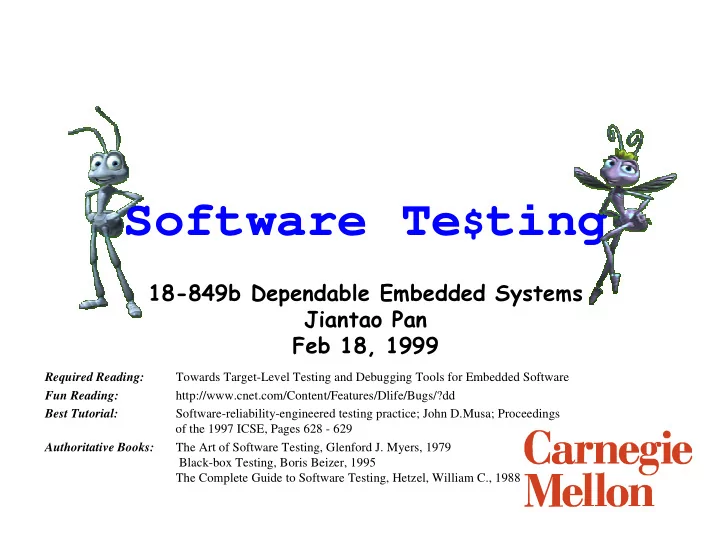

Software Te $ ting ����������������������������������� ����������� ������������ Towards Target-Level Testing and Debugging Tools for Embedded Software Required Reading: http://www.cnet.com/Content/Features/Dlife/Bugs/?dd Fun Reading: Software-reliability-engineered testing practice; John D.Musa; Proceedings Best Tutorial: of the 1997 ICSE, Pages 628 - 629 The Art of Software Testing, Glenford J. Myers, 1979 Authoritative Books: Black-box Testing, Boris Beizer, 1995 The Complete Guide to Software Testing, Hetzel, William C., 1988
You Are Here ◆ A lot of subtle relations to other topics SW RELIABILITY VERIFICATION/ VALIDATION/ CERTIFICATION 2
Introduction ◆ Definitions of Software Testing • [1]: Testing is the process of executing a program or system with the intent of finding errors. • [3]: Testing is any activity aimed at evaluating an attribute or capability of a program or system and determining that it meets its required results. ◆ Vocabulary & Concepts • Defects, bugs, faults[ANSI], errata[Intel] • Testing is more than debugging[BEIZER90] ◆ Software testing is an …… ��� • because we still can not make it a science ◆ Software testing is everywhere • in every phase of software life cycle, whenever software changes • 50%+ time in debugging/testing ◆ Software testing is not mature 3
Why testing? ◆ For Quality • bugs kill – in a computerized embedded world • Defect detection (find problems and get them fixed [KANER93]) – Better early than late » Difficult to upgrade field software in embedded systems • To make quality visible [HETZEL88] ◆ For Verification & Validation(V&V): • show it works: – clean test/positive test • or it can handle exceptional situations: – dirty test/negative test ◆ For Reliability Estimation [KANER93] • E.g. reliability growth testing 4
Why software testing is difficult -- principles ◆ Software fails in different ways with physical systems ◆ Imperfection of human nature(to handle complexity) ◆ Cannot exterminate bugs • We cannot test a typical program completely • The Pesticide Paradox[BEIZER90] – Every method you use to prevent or find bugs leaves a residue of subtler bugs against which those methods are ineffectual. – Fixing the previous(easy) bugs will tend to increase software complexity --> introducing new subtler bugs • The Complexity Barrier[BEIZER90] – Software complexity(and therefore that of bugs) grows to the limits of our ability to manage that complexity. 5
Software Testing: Taxonomy ◆ By purposes ◆ By scope • Correctness testing • implied in [BEIZER95] – Black-box – Unit testing – White-box – Component testing • Performance testing – Integration testing • Reliability testing – System testing • or in [PERRY90] – Robustness testing » Exception handling testing – Unit testing » Stress/load testing – String testing • Security testing – System testing ( α test) ◆ By life cycle phase [PERRY95] – Acceptance testing ( β test) • Requirements phase testing • Design phase testing • Program phase testing • Evaluating test results • Installation phase testing • Acceptance testing • Testing changes: maintenance 6
Correctness Testing ◆ Needs some type of oracles ◆ Black-box testing/behavioral testing • also: data-driven; input/output driven[1]; requirements-based[3] • Test data are derived solely from the program structure[9] • “Exhaustive input testing”[1] • But, what about omissions/extras in spec? ◆ White-box testing/structural testing • also: logic-driven[1]; design-based[3] • Application of test data derived from the specified functional requirements without regard to the final program structure[9] • “Exhaustive path testing”[1] • But, what about omissions/extras in code? ◆ Other than bugs, we may find: • Features • Specification problems • Design philosophy (e.g. core dumps v.s. error return code) 7
Correctness Testing Methods/Tools ◆ Control-flow testing • Trace control-flow using control-flow graph; coverage ◆ Loop testing Flow- • A heuristic technique; should be combined with other methods coverage • Applied when there is a loop in graph testing ◆ Data-flow testing • Trace data-flow using data-flow graph; coverage ◆ Transaction-flow testing • Testing of on-line applications and batch-processing software • Has both control-flow and data-flow attributes ◆ Domain testing • Software dominated by numerical processing ◆ Syntax testing • Command-driven software and similar applications ◆ Finite-state testing • Using finite-state machine model • motivated from hardware logic design • Excellent for testing menu-driven applications 8
When to stop testing? ◆ Trade-off between budget+time and quality • Part of acceptance testing ◆ Stopping rules: • When reliability meets requirement – Statistical models » E.g. reliability growth models – Data gathering --> modeling -->prediction – Not possible to calculate for ultra-dependable system » Because failure data is hard to accumulate • When out of resources: test case, money and/or time 9
Testing is Controversial ◆ Alternatives to testing • “human testing[MYERS79]” – inspections, walkthroughs, reviews • Engineering methods – Clean-room v.s. testing • Formal Verification v.s. Testing ◆ Flames • Traditional coverage-based testing is flawed. • Testing can only prove the software is flawed. • Inspection/review more effective than testing? • “If we have good process, good quality, we don't need much testing” 10
Conclusions ◆ Complete testing is infeasible • Complexity problem • Equivalent to Turing halting problem ◆ Software testing is immature • Crucial to software quality ◆ Testing is more than debugging • For quality assurance, validation and reliability measurement ◆ Rules of thumb • Efficiency & effectiveness • Automation ◆ When to stop: need good metrics • Reliability • Time & budget 11
List of References ◆ [1][MYERS79] The art of software testing ◆ [2][BEIZER95] Black-box Testing ◆ [3][HETZEL88] The Complete Guide to Software Testing ◆ [4][PHAM95] Software Reliability and Testing, pp29 ◆ [5][KANER93] Testing Computer Software ◆ [6][PERRY95] Effective Methods for Software Testing, William Perry, 1995 QA76.76.T48P47X ◆ [7][BEIZER90] Software Testing Techniques ◆ [8]http://www.cs.jmu.edu/users/foxcj/cs555/Unit12/Testing/index. htm ◆ [9][PERRY90] A standard for testing application software, William E. Perry, 1990 12
Recommend
More recommend